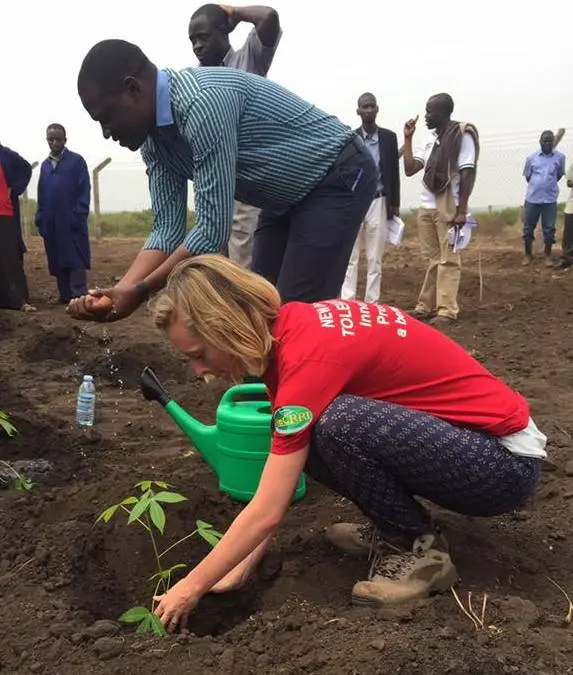Last week I helped plant a new confined field trial for genetically modified (GM) cassava in western Uganda. The aim is to find how well the plants resist Cassava brown streak disease (CBSD).
Before planting, the National Crops Resources Research Institute (NaCRRI) held discussions with people from the local government and farmers’ groups. It’s vital to engage the local community so that people are correctly informed and on-board with the project. There were certainly some very strange myths to debunk!
Henry Wagaba (Head of Biosciences at NaCRRI) explained the huge losses caused by CBSD, which spoils tubers and can wipe out entire fields. CBSD is now the most devastating crop disease in Uganda and there are no resistant varieties currently available.
To fight the disease, NaCRRI researchers have developed GM cassava plants, which show high levels of resistance to CBSD at sites in southern and central Uganda. This trial will test how the plants perform in the growing conditions in western Uganda. Work will also be carried out to cross the GM plants wither farmer varieties to improve their growing and taste qualities.
GM crops are a contentious topic in Uganda. The passing of a National Biotechnology and Biosafety law has stalled in Parliament for over three years due to disagreements. Currently GM technology is used for research on banana, cassava, maize, potato, rice and sweet potato. However these are not approved for human consumption.
In nearby countries Kenya and Sudan, GM food products have been approved and many of these food products are imported into Uganda without regulation. It’s hoped the law will be passed soon to enable Ugandan farmers to reap the benefits of GM crops and protect against any potential risks.
More from this blog series:
Before planting, the National Crops Resources Research Institute (NaCRRI) held discussions with people from the local government and farmers’ groups. It’s vital to engage the local community so that people are correctly informed and on-board with the project. There were certainly some very strange myths to debunk!
Henry Wagaba (Head of Biosciences at NaCRRI) explained the huge losses caused by CBSD, which spoils tubers and can wipe out entire fields. CBSD is now the most devastating crop disease in Uganda and there are no resistant varieties currently available.
To fight the disease, NaCRRI researchers have developed GM cassava plants, which show high levels of resistance to CBSD at sites in southern and central Uganda. This trial will test how the plants perform in the growing conditions in western Uganda. Work will also be carried out to cross the GM plants wither farmer varieties to improve their growing and taste qualities.
 |
| I enjoyed getting stuck in and planting my first GM cassava! |
In nearby countries Kenya and Sudan, GM food products have been approved and many of these food products are imported into Uganda without regulation. It’s hoped the law will be passed soon to enable Ugandan farmers to reap the benefits of GM crops and protect against any potential risks.
 |
| Before the trial, I went on a safari in the Queen Elizabeth National Park, where I saw elephants, hippos and even lions! |
-----------------------------------
This blog has been written by University of Bristol Cabot Institute member Katie Tomlinson from the School of Biological Sciences. Katie's area of research is to generate and exploit an improved understanding of cassava brown streak disease (CBSD) to ensure sustainable cassava production in Africa. This blog has been reposted with kind permission from Katie's blog Cassava Virus.
 |
| Katie Tomlinson |
Blog 2: Week one: Settling in to Ugandan life
Blog 3: Learning the ropes
Blog 4: Clean cassava to solve brown streak problem?
Blog 5: Taking a trip to the cassava field!
Blog 6: Using GM to fight cassava brown streak disease
Blog 3: Learning the ropes
Blog 4: Clean cassava to solve brown streak problem?
Blog 5: Taking a trip to the cassava field!
Blog 6: Using GM to fight cassava brown streak disease

